
Established: 1997
Positions: 2
Program Site Address:
Hu Hu Kam Memorial Hospital Eye Clinic
483 W. Seed Farm Road
Sacaton, Arizona 85147
Mailing Address:
Hu Hu Kam Memorial Hospital Eye Clinic
Attn: Dr. Mackenzie Black
P.O. Box 38
Sacaton, Arizona 85147
Email: msblack@grhc.org
Program Coordinator & Residency Team
Residency Coordinator: Mackenzie Black, OD, FAAO
Dean Fasciani, OD, FAAO, Director of Optometry and Student Program Coordinator
Erin Havens, OD
Sarah David, OD
Stephanie Gee, OD, MPH, FAAO

Mission Statement
The fundamental mission of the Hu Hu Kam Memorial Hospital residency program is to provide qualified postdoctoral optometric practitioners with outstanding educational experiences focused on general eye care optometry and ocular disease with additional specialized skills within a medical center and public health care system.
The program strives to create an atmosphere that fosters compassionate appreciation for the needs of patients from all backgrounds, especially for the Native American population that the residency serves.
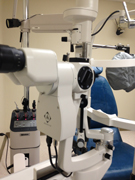
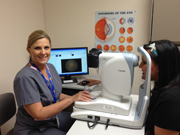
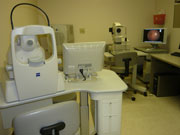
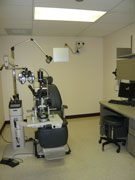
Program Description
Program Goals
- Strengthen the resident’s primary eye care skills and ocular disease management.
- Provide the resident with a practical understanding of their role as a member of each patient’s health care team.
- Expand the resident’s health care knowledge base.
- Provide a didactic education to enhance the resident’s clinical decision making skills.
- Provide the resident with the opportunity to become an effective educator.
Program Objectives
- Ensure the resident performs a vast array of primary care examinations.
- Strengthen the residents’ ability to diagnose, treat, and manage ocular pathology.
- Give the resident experience in postoperative care.
- Integrate the resident to the health care team model.
- Ensure that the resident fully utilizes other hospital clinical and support services.
- Give the resident an opportunity to observe ophthalmology subspecialties.
- Expose the resident clinically to other health care disciplines.
- Educate the resident as to the process of manuscript preparation.
- Instill in the resident the importance of keeping up with new advances and management strategies in eye care.
- Enhance the resident’s ability to properly diagnose, treat and manage ocular pathology through regular case discussion.
- Strengthen the resident’s technical skills through systematic instruction and hands-on training covering basic and advanced clinical techniques via participation in clinical workshops.
- Educate the resident as to the means to prepare and present a clinical lecture.
- Give the resident an opportunity to mentor fourth-year optometry students.
Typical Daily or Weekly Schedule in Clinic
- The duration of the program is 12 months, July 1st to June 30th.
- Normal clinic hours are from 7:30 a.m. – 6:00 p.m., Monday through Friday. The resident carries a four day, 10 hour per day work schedule with one week day off each week to use as desired – either as an extra personal day or to moonlight at an off-site clinic to network and supplement the resident income.
- The resident spends 80–90% of his/her time in direct patient care. Most of the time this will be served in the Eye Clinic, but on occasion it may include evaluation of patients in the Emergency Room, inpatients on the ward and occasional participation in screenings at local schools and local health fairs.
- Didactic training is emphasized through daily case discussion, weekly lectures, grand rounds, journal club meetings, photo reviews, quarterly workshops and assigned case reports.
Rotation through other Services
- Internal rotations include:
- Primary Care
- Life Center/Diabetes Care Program
- Podiatry
- Rheumatology
- Laboratory
- Others based on availability – Pediatrics, Emergency Department, Pharmacy
External rotations include:
The resident will follow pre- and post-operative cases, observe ophthalmological surgery and clinical care with the following specialists:
- Retina
- Glaucoma
- Cataract
- Oculoplastics
- Cornea, as available

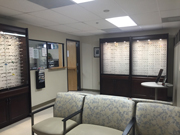
Type and Number of Patients
Hu Hu Kam Memorial Hospital has approximately 50,000–60,000 patient visits a year. The facility has 16 beds and provides health care for over 20,000 patients within the Gila River Community. The hospital provides outpatient services including Optometry, Ophthalmology, Podiatry, Adult Medicine, Pediatrics and many more. Optometry residents are trained to provide comprehensive primary eye care primarily to members of the Native American population.
Teaching Responsibilities
The resident has the opportunity to mentor fourth-year optometry students. Although student precepting is not the primary responsibility of the resident doctor, residents do precept on occasion over the course of their residency.
Four to six student interns rotate through the site on a quarterly basis, and regular resident mentoring responsibilities include leading case discussions and grand rounds cases, preparing and delivering presentations on various topics, training on special testing equipment, leading regularly scheduled journal club meetings and general discussion on basic clinical information or new developments including anterior segment and fundus photo review.
Lecturing Opportunities
- The resident will present lectures on a regular basis in the Eye Clinic to students and preceptors.
- The resident will present a case report at the annual IHS conference and at Midwestern Residents' Day in Glendale Arizona.
- The resident may be involved in diabetic retinopathy discussions in the hospital wellness center.
- The resident may present an ocular disease presentation to the medical staff.
Requirements for Residency Completion
(As reflected in the Hu Hu Kam Memorial Hospital Written Curriculum, Residency brochure, Residency Highlights page and SCCO web site)
NOTE: It is expected that the resident will obtain Arizona licensure during the first three months of residency at Hu Hu Kam Memorial Hospital.
1. CASE REPORTS: The resident is required to write two case reports of publishable quality suitable for submission to a referred professional journal and that meet requirements set forth by the American Academy of Optometry for membership. The residency coordinator will help guide the resident with topic selection and preparation for the papers. A poster may be submitted in lieu of one case report.
2. OPTOMETRIC MEETINGS: The resident is required to attend and present a case report at the Indian Health Service meeting and Midwestern Residents’ Day. The resident is also required to attend a national optometric meeting, and is highly encouraged to fulfill this requirement via attendance at the American Academy of Optometry meeting.
3. STEADY COMPLIANCE WITH ATTENDANCE AND PARTICIPATION AS IT PERTAINS TO SCHOLARLY AND DIDACTIC ACTVITIES AS SCHEDULED BY THE RESIDENCY COORDINATOR, INCLUDING THE FOLLOWING:
- Regular case discussions (grand rounds sessions), ocular disease photo reviews, student/resident lectures, journal club meetings and resident work shops
- Monthly or bi-monthly retina clinic and monthly glaucoma clinic
- Kid’s clinic & Kids Fest pediatric screenings
- Additional presentations and patient education opportunities, as scheduled
- Hospital CME, as the clinic schedule allows
- Internal and external observations
- Staff meetings, monthly
- Assigned residency projects
- Completion of required reading list
4. PATIENT CARE: Patient care must be satisfactory or outstanding, with steady improvement throughout the residency, based on preceptor and Residency Coordinator evaluations.
5. TIMELY SUBMISSION OF REQUIRED PAPERWORK: The resident is required to submit all paperwork including case reports and quarterly and end of the year residency evaluations in a timely fashion, as scheduled by the residency coordinator and/or SCCO. Quarterly requirements will also include resident participation in formal clinical quality assurance measures consisting of quarterly chart reviews and competency assessments.
Additional Employment Opportunities
Due to the four ten-hour work week schedule, the resident will have one week day to use, at their option, for moonlighting purposes in order to supplement their resident income and to network for future employment opportunities.
Stipend
The stipend is $50,294 for the 12-month program and is not dependent on the resident’s performance.
Benefits
| Health | Employee related immunizations are required and available at no charge. The resident is offered health insurance through Gila River Health care at a set fee. |
| Holidays | The resident will receive hospital-approved holidays off. |
| Educational Travel | Approved continuing education and travel funding is available through Gila River Health Care in the amount of $500. |
| Vacation | The resident will receive (8) 10-hour days of personal leave and (8) 10-hour days of sick leave. |
| Liability | Liability coverage will be through the Federal Tort Act. |
| Continuing Education | The resident is given five days of continuing education leave in order to attend the two required optometric meetings as listed under the requirements for residency completion section. |
Prerequisites
- OD degree from a school or college of optometry accredited by the Accreditation Council on Optometric Education (include transcripts).
- Applicants must have attained or must currently have a cumulative GPA of 2.50 on a scale of 4.0 for the optometric education.
- Passage of NBEO (include transcripts of NBEO scores).
- Obtain a license to practice Optometry in the State of Arizona. It is mandatory to take and pass the Arizona State Board. The prerequisite may be satisfied during the first three months of the residency to allow time for the Arizona board to release licensure.
- Candidates must apply through the Optometry Residency Match site (ORMatch).
- U.S. Citizenship is required.
Applicant must provide:
- Letter of intent stating the reasons for applying to the program.
- Current Curriculum Vitae
- Three letters of recommendation preferably from faculty members most responsible for the clinical education of the resident.
- Official optometry school transcripts
Interviews will be requested of specific candidates based upon the quality of their credentials and application information.
No candidate will be discriminated against based upon race, color, sex, religion, creed, national origin, age, non-disqualifying physical impairment, or sexual orientation.
Selection Criteria/Ranking
Approximate weights are placed on each of the following categories by the residency coordinator and are applied in a uniform matter to all applicants:
- GPA ~20%
- NBEO ~20%
- Curriculum Vitae ~10%
- Letter of Intent ~10%
- Letter of Recommendations ~20%
- Special qualities/characteristics ~20%
- Maturity
- Professionalism
- Compassion
- Likability
- Ability to get along with others
- Personality that is complementary to clinic doctors and staff
- Genuine affect
- Native American preference
Program Accreditation
The Accreditation Council on Optometric Education (ACOE) has granted the Hu Hu Kam Memorial Hospital Residency Program the accreditation status of “Accredited.” The next scheduled site visit will take place in June 2028. Accredited is a classification granted to an educational program indicating that the program generally meets the Standards for accreditation. For more information, see the ACOE’s website at www.theACOE.org or contact the ACOE at accredit@theacoe.org.
Accreditation Council on Optometric Education
243 N. Lindbergh Blvd., Suite 301
St. Louis, MO 63141
Phone: 1-800-365-2219
E-mail address: accredit@theacoe.org
Housing
Not provided.
Local Activities & Attractions
Hu Hu Kam Memorial Hospital is located in Sacaton, Arizona on the Gila River Indian Community, approximately 30 miles south of Phoenix. Most individuals who work at the hospital live in Chandler, Gilbert, Tempe, Casa Grande or Queen Creek, all suburbs of Phoenix. Arizona State University is located in Tempe and is adjacent to Chandler.
The weather is ideal for year round outdoor recreational activities. The summers are hot, with temperatures above 100 degrees. There are lakes nearby for water sports and fishing. The Grand Canyon is located in northern Arizona, along with other local attractions such as Tuzigoot and Tonto National Monuments, Sedona, Tortilla Flats, and many others. There are also several ski areas such as Mount Lemon in Tucson and Sunrise in the White Mountains. Hiking trails are abundant in the valley and surrounding areas, and Phoenix lies within a 6-hour radius from the west coast, Las Vegas and many other exciting southwestern destinations.
Contact Info
Mackenzie Black, OD, FAAO
Staff Optometrist and Residency Program Coordinator
Hu Hu Kam Memorial Hospital
P.O. Box 38
Sacaton, AZ 85147
602.271.7960 x7326 • Fax: 602.271.7872 • Email: msblack@grhc.org
Judy W.H. Tong, OD, FAAO
Assistant Dean of Residencies
Southern California College of Optometry at
Marshall B. Ketchum University
2575 Yorba Linda Blvd.
Fullerton, CA 92831-1699
714.449.7429 • Fax: 714.992.7811• Email: jtong@ketchum.edu
Former Resident Contacts:
Dr. Dean Fasciani dfasciani@grhc.org
Dr. Sarah David sdavid@grhc.org
Former Resident Testimonials:
What are some of the highlights from your Hu Hu Kam residency thus far?
“Definitely the challenge of being able to recognize systemic manifestations of ocular disease, ordering appropriate diagnostic testing and making decisions in the treatment and management of a case. Fortunately, this clinical decision making is made easier by all of the knowledgeable precepting doctors. Each doctor wants you to succeed and pushes you to become a well-versed clinician. Despite being challenging, the clinic environment is extremely enjoyable and fun. Each and every member of the optometric team helps one another and strives to provide the best possible care to our patients that we can!”
Dr. Dean Fasciani, ‘12-’13 Resident
“I love our patient base and the variety and complexity of eye care that I am able to provide. We get to see patients of all ages, both male and female alike, and manage all types of ocular conditions. I thought that my clinic at school was very disease heavy but the conditions I have encountered at HHK have challenged and expanded my diagnostic and treatment skills tremendously. Having several experienced doctors to consult with on difficult cases is invaluable. They are all accessible and up to date on how to effectively care for complex patients. I love discussing cases with them. All of the docs make learning enjoyable, and they help mold you into a better clinician. Getting to present cases to a retinal specialist and work side by side in clinic with him has improved my ability to critically think about cases and management options. I do not think there is a residency program that can rival the level of disease, diversity, and clinical challenge offered by HHK.
Dr. Joseph Brewer ‘16-’17 Resident
So what is so great about your residency?
“Well, for starters, working with 3 compassionate, efficient and intelligent staff optometrists, a co-resident and a dozen or so third year optometry students over the course of the year really creates a unique and engaging environment. The well-trained support staff doesn’t hurt either! Mixing so many optometry backgrounds helps me as a Doctor become more well-rounded in my patient care.”
Dr. Rachel Grant, ‘12-’13 Resident
Looking back on your residency, what experiences do you feel most prepared you to confidently treat and manage your patients?
“I am very comfortable managing patients with coexisting ocular and systemic pathologies which I attribute to the exposure to the complex patient cases at Hu Hu Kam and the interactive discussions amongst the residents, students and staff doctors.”
Dr. Adam Lee, ‘08-’09 Resident
“Now that I’m a practicing optometrist I realize how much confidence and experience this residency gave me. In optometry school we have minimal clinical exposure to disease treatment and observation of surgical procedures. This residency provided significant exposure to both. This residency was the best decision of my optometric career.”
Dr. Bobbie Jo Casey, ‘08-’09 Resident
